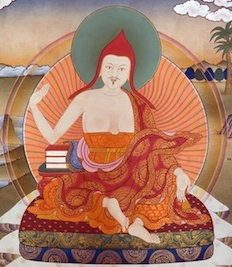Madhyamakāvatāra
Madhyamakāvatāra (T. dbu ma la 'jug pa དབུ་མ་ལ་འཇུག་པ་), or Introduction to the Middle Way, is as major work by Chandrakirti on Madhyamaka philosophy. In the Tibetan tradition, the text is classified as a commentary on the meaning of the Mulamadhyamaka-karika and on the Sutra of the Ten Bhumis.[1] The text consists of a root text in verse together with an auto-commentary.[2]
This text became extremely influential in Tibet, where it was regarded it as the seminal text for the study of Madhyamaka and scholars from all schools of Tibetan Buddhism wrote commentaries on it.[2] This text was included as one of the five ‘key texts’ into the curriculum of the Gelug school,[2] as one of the the "thirteen great texts" of the Nyingma curriculum.
Meaning of the Title
Madhyamaka refers to the texts which express the meaning of the middle way beyond extremes, both the Buddha's teachings of the second turning and the commentaries that further elucidate their meaning. Specifically here it refers to Nagarjuna's Mulamadhyamaka-karika.[1]
Avatara means entry or introduction. This text is an introduction in the sense that it clearly brings out the meaning of Nagarjuna's text by means of both scriptures from the sutras as well as the pith instruction passed down through the lineage of masters from Nagarjuna to Chandrakirti. It expresses both the profound aspect of Nagarjuna's text, namely emptiness, as well as the vast aspect, the paths and bhumis.[1]
Structure
The text has eleven chapters, corresponding to the ten bhumis and the state of buddhahood.
Translations
English
- Geshe Rabten, Echoes of Voidness, translated and edited by Stephen Batchelor, Wisdom, 1983
- Huntington, C.W., The Emptiness of Emptiness, University of Hawaii Press, 1989
- Introduction to the Middle Way with Mipham Rinpoche's Commentary, translated by Padmakara Translation Group, Shambhala, 2002
- Introduction to the Middle Way: Chandrakirti's Madhyamakavatara with commentary by Dzongsar Jamyang Khyentse Rinpoche, edited by Alex Trisoglio, Khyentse Foundation, 2003
- The Karmapa's Middle Way: Feast for the Fortunate (translation of Chandrakirti's root text along with commentary by the Ninth Karmapa, Wangchuk Dorje), translated by Tyler Dewar, Snow Lion, 2008.
French
- Louis de la Vallée Poussin: Madhyamakavatara par Candrakirti, Bibliotheca Buddhica IX. Osnabrück, Biblio Verlag, 1970. Available for free download here
Commentaries
Indian
- Jayananda, Ṭīkā
Tibetan
 དབུ་མ་ལ་འཇུག་པའི་འགྲེལ་མཆན་ལེགས་པར་བཤད་པ་ཟླ་བའི་འོད་ཟེར་, dbu ma la 'jug pa'i 'grel mchan legs par bshad pa zla ba'i 'od zer
དབུ་མ་ལ་འཇུག་པའི་འགྲེལ་མཆན་ལེགས་པར་བཤད་པ་ཟླ་བའི་འོད་ཟེར་, dbu ma la 'jug pa'i 'grel mchan legs par bshad pa zla ba'i 'od zer
 དབུ་མ་འཇུག་པའི་འབྲུ་འགྲེལ་བློ་གསལ་དགའ་བའི་མེ་ལོང་, dbu ma 'jug pa'i 'bru 'grel blo gsal dga' ba'i me long
དབུ་མ་འཇུག་པའི་འབྲུ་འགྲེལ་བློ་གསལ་དགའ་བའི་མེ་ལོང་, dbu ma 'jug pa'i 'bru 'grel blo gsal dga' ba'i me long
In Translation
- Jeffrey Hopkins, Compassion in Tibetan Buddhism, Ithaca: Snow Lion, 1980 (first five chapters based on Tsongkhapa’s commentary)
- Rendawa Shonnu Lodro, Commentary on the Entry into the Middle, Lamp which Elucidates Reality, translated by Stotter-Tillman & Acharya Tashi Tsering, Sarnath, Varanasi, 1997.
- Eight Karmapa Karmapa Mikyo Dorje, The Moon of Wisdom: Chapter Six of Chandrakirti's Entering the Middle Way with Commentary from the Eighth Karmapa Mikyo Dorje's Kagyu Siddhas, Snow Lion, 2006, ISBN 978-1559392310
Further reading
- Kevin A. Vose, Resurrecting Candrakirti: Disputes in the Tibetan Creation of Prasangika (Boston: Wisdom Publications, 2009)
Notes
- ↑ 1.0 1.1 1.2
 Introduction to the Middle Way, Rigpa Shedra Wiki
Introduction to the Middle Way, Rigpa Shedra Wiki
- ↑ 2.0 2.1 2.2 Westerhoff 2018, p. 132.
Sources
 Westerhoff, Jan (2018), The Golden Age of Indian Buddhist Philosophy, Oxford University Press
Westerhoff, Jan (2018), The Golden Age of Indian Buddhist Philosophy, Oxford University Press
External links
 Madhyamakāvatāra, Wikipedia
Madhyamakāvatāra, Wikipedia Introduction to the Middle Way, Rigpa Shedra Wiki
Introduction to the Middle Way, Rigpa Shedra Wiki Brief commentary by Khenpo Namdrol Rinpoche, Lotsawa House
Brief commentary by Khenpo Namdrol Rinpoche, Lotsawa House
